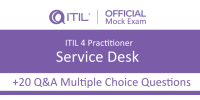One year ago, many organizations had to send their employees to work from home. But what was meant to be a temporary situation seems to turn into something permanent.
Spotify has announced that employees will be free to ‘work from anywhere’ (even another country) from now on. Nationwide Insurance has permanently transitioned to a blended work model: employees can go into the office if it is safe, but can work remotely whenever they want.
Many other businesses are following suit, and that means that employers all over the world should be writing up new policies and procedures for remote working. It’s important that leaders construct and communicate them properly.
ITIL® 4: Direct, Plan, and Improve outlines nine recommendations for writing effective policies.
1. Be clear and concise
If your policies are long, complicated, or dense, no one will read them. Keep it clear and concise so that your employees can understand and absorb the information.
2. Keep it simple and practical
Policies should instruct people to act or not act on something. Make it clear what you expect your teams to do or not do.
If there are specific tools or systems they need to use, documents to update, or procedures to follow, state that in the policy so that readers know at a glance what they need to do.
3. Anticipate questions
Before you publish a new policy, try to imagine what questions the readers will have when they first see it. Then go back and add the answers to those questions to the document, either as text in the main body of the policy or in an FAQ sheet.
4. Educate and communicate
New policies sometimes need to be supported by training. Ensure that key stakeholders understand the policy after it is published and offer them support if they don’t.
5. Build in flexibility
Any exceptions to the policy must be documented. Good policies allow for flexibility in unusual situations.
There should be a documented process for requesting, considering, and resolving policy exceptions.
6. Define the consequences of non-compliance
Policies must be followed, so there need to be consequences for employees who fail to do so. These should be documented in the policy itself.
Administer consequences consistently and fairly so that the policy is not ignored.
7. Build in measurement and compliance validation
Your organization should have a standard procedure for measuring compliance to policies. Everyone who follows a policy should be praised. Anyone who fails to follow a policy should be coached until they become compliant.
8. Promote transparency
Keep your policies somewhere everyone can access them. If you have remote employees, they should be online so that any employee can easily reference them.
9. Enable feedback
Policies should be developed collaboratively. Ask stakeholders for their input and feedback. If everyone has been involved in the policy creation, people will be more invested and more likely to follow it correctly.
These nine recommendations will help you to define policies that are clear, fit for purpose, and effective.
Source: Axelos by Amy Metcalfe - Project Editor, AXELOS








